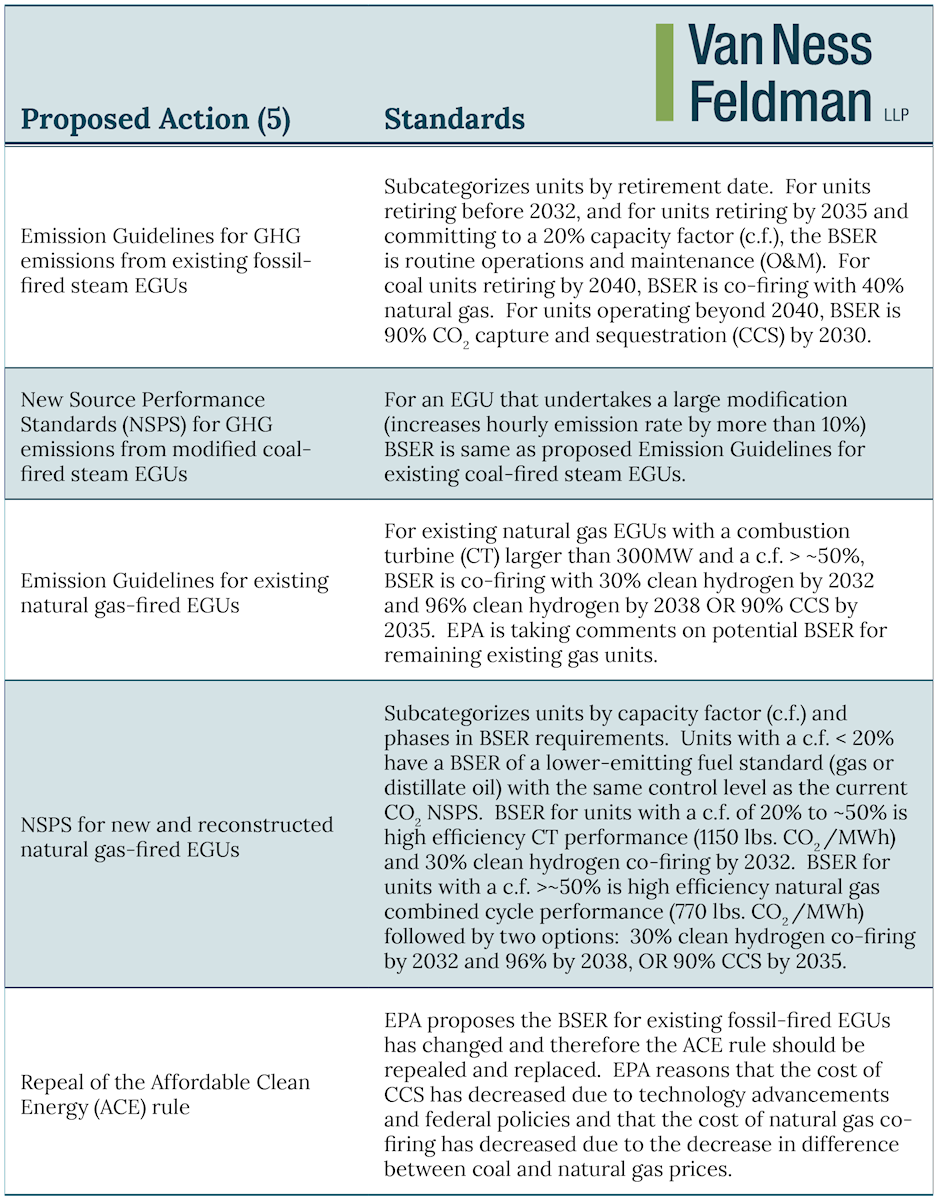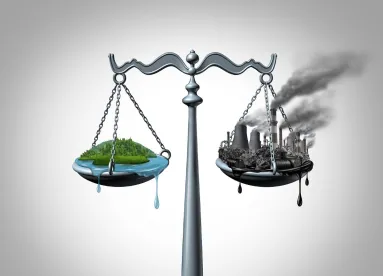Introduction
On May 11, 2023, the U.S. Environmental Protection Agency (EPA) proposed new carbon dioxide (CO2) standards for power plants under the Clean Air Act. In the proposal, EPA sets emissions limits for certain existing, modified, new, and reconstructed fossil fuel power plants based on factors including size, how often the plant runs, and retirement dates. The standards are based on the use of new technologies including CO2 capture and sequestration (CCS) and co-firing with clean hydrogen.
Specifically, the proposed rule:
-
Establishes Emission Guidelines for states to develop CO2 performance standards for existing coal-fired electric generating units (EGUs)
-
Establishes CO2 performance standards for modified coal-fired steam EGUs
-
Establishes Emission Guidelines for states to develop CO2 performance standards for existing natural gas-fired EGUs
-
Establishes CO2 performance standards for new and reconstructed natural gas-fired EGUs
-
Repeals the Affordable Clean Energy (ACE) rule
Under the proposed rules, plants do not face significant requirements until 2030. By that date, any coal-fired power plant intending to operate past 2040 would have to install a CCS system that captures 90% of its CO2 emissions by 2030. In addition, any large, frequently operating natural gas-fired power plant would have to either install a 90% capture CCS system by 2035 or operate nearly entirely on clean hydrogen by 2038.
EPA is proposing the rules pursuant to Clean Air Act (CAA) section 111 following much litigation regarding controlling greenhouse gas emissions (GHGs) from the power sector. If finalized, the rules would have substantial impacts on the electricity-generating system of the United States.
Background
Regulatory background. CAA section 111 directs EPA to establish standards for controlling air pollutants for categories of major stationary sources, which include electric generating units (EGUs). Section 111 outlines a two-step process for establishing a standard of performance for emissions from EGUs. Under the first step, EPA determines the “best system of emission reduction” (BSER) for the relevant pollutant that is “adequately demonstrated,” taking into consideration cost, any non-air quality health and environmental impacts, and energy requirements. EPA then sets a standard that quantifies the “degree of emission limitation achievable through the application” of the BSER. Sources subject to the standard of performance can use any system of reduction to meet the limit; they are not required to use the system EPA determined is the BSER.
Under section 111(b), EPA has the authority to promulgate New Source Performance Standards (NSPS) that apply to new, modified, and reconstructed sources in a source category. EPA may separate sources in a category and promulgate different standards of performance for those sources; for example, the fossil fuel-fired boilers category currently is subcategorized into coal, oil, and natural gas.
Section 111(d) applies to existing sources in a regulated source category. However, EPA’s use of section 111(d) is subject to a number of conditions. First, EPA may only invoke its section 111(d) authority to address a type of air pollutant not already subject to regulation as a “criteria” air pollutant (pursuant to Clean Air Act section 108) or a hazardous air pollutant (pursuant to Clean Air Act section 112). GHGs are a pollutant that falls in this gap. Second, performance standards can only be established under section 111(d) after EPA has set an NSPS for the new or modified sources in a source category under section 111(b).
Third, section 111(d) provides that EPA establish a procedure for states to establish performance standards for existing sources in the source category, rather than allowing EPA direct authority to set national standards. Under this procedure, EPA first develops an “Emission Guideline” that is a benchmark standard of performance for the source category. Each state then develops and submits to EPA a plan for establishing and enforcing standards of performance for the regulated sources in the state. While the state plans must achieve reductions equivalent to those specified by the Emission Guideline, the plans do not have to require each regulated source in the state to meet the same standard.
The CAA and EPA regulations also permit a state to set less stringent standards or longer compliance schedules for an existing source in its section 111(d) plan based on certain factors: unreasonable cost of control; a limited remaining useful life; physical impossibility of installing necessary control equipment; or other factors making less stringent limits or schedules appropriate for the source.
Policy and litigation background. EPA actions regarding regulation of power plant GHGs under CAA section 111 have been the subject of regulatory action and litigation since they were initially proposed during the Obama Administration. President Obama’s EPA promulgated a section 111(b) rule for coal- and natural gas-fired EGUs. The Obama EPA also promulgated a section 111(d) rule for existing EGUs through a rule called the Clean Power Plan (CPP). For existing units, the CPP relied on a BSER predicated on shifting generation from high-emitting to low- or zero-emitting facilities. But more recently, the Trump Administration rescinded the CPP with the Affordable Clean Energy (ACE) rule, finding the CPP was based on an invalid legal interpretation of section 111. The ACE rule replaced the CPP with more limited GHG standards just for existing coal-fired facilities based on efficiency improvements.
The U.S. Court of Appeals for the District of Columbia vacated the ACE rule in January 2021 in American Lung Association v. EPA. In vacating the rule, the D.C. Circuit found that the Trump Administration incorrectly interpreted CAA section 111(d) in arguing that any GHG standards could only be based on “inside-the-fence” requirements.
In June 2022, the U.S. Supreme Court reversed the D.C. Circuit’s decision on the validity of the CPP in West Virginia v. EPA. The Court applied the “Major Questions Doctrine,” where a court may provide a more skeptical review of an agency action when the agency “claim[s] to discover” in a “long-extant” statute an “unheralded power” representing a “transformative expansion of its regulatory authority” with substantial national impacts; such cases provide “every reason to hesitate before concluding that Congress meant to confer on EPA the authority it claims under Section 111(d).” The Court found that the CPP’s generation-shifting approach effectively would allow EPA to restructure the power sector—a substantial exercise of regulatory power that only could be justified by a “clear statement of Congressional authority.” Not finding such a clear statement of authority in the Clean Air Act, the Court invalidated the CPP.
The ACE rule was not explicitly but rather indirectly reinstated by the D.C. Circuit after the Supreme Court reversed and remanded the case, as the Court did not address the validity of the rule. EPA informed the D.C. Circuit that the agency was in a rulemaking process to replace the ACE rule, so the D.C. Circuit placed the case in abeyance pending completion of the rulemaking rather than address the factual and legal arguments raised.
In 2022, Congress passed the Inflation Reduction Act (IRA), a landmark investment in combatting climate change, which included new and expanded tax credits as well as federal funding for hydrogen production; carbon capture, utilization, and sequestration (CCUS); and renewable energy production and infrastructure. The latest EPA rulemaking package accounts for funding impacts from the IRA.
The Proposal
The rulemaking package (1) establishes Emission Guidelines for states to develop CO2 performance standards for existing coal-fired electric generating units (EGUs); (2) establishes CO2 performance standards for modified coal-fired steam EGUs; (3) establishes Emission Guidelines for states to develop CO2 performance standards for existing natural gas-fired EGUs; (4) establishes CO2 performance standards for new and reconstructed natural gas-fired EGUs; and (5) repeals the Affordable Clean Energy (ACE) rule.
The proposed standards are summarized in the table below.
EPA’s Proposed Actions under the Clean Air Act

For emission guidelines for existing fossil fuel-fired steam generating units and large, frequently operated fossil fuel-fired combustion turbines, EPA is also proposing requirements for state plans. The proposed deadline for submission of state plans is two years after the effective date of the regulation. The proposal also prescribes how states may implement the remaining useful life and other factors (RULOF) provision of CAA section 111(d). Finally, EPA is proposing to allow states to include trading or averaging in state plans as long as the plan can assure equivalent emissions reductions.
EPA notes climate and public health benefits of its rulemaking. The proposed rules may reduce 1 billion metric tons of CO2 emissions by 2042, as well as additional criteria pollutant emissions. EPA states the proposals could provide up to $85 billion in net climate and public health benefits over the next two decades.
Potential Impact
If finalized as proposed, the standards will have the effect of significantly decreasing fossil-fuel related CO2 emissions from coal- and natural gas-fired utilities in the United States. Importantly, the proposal assumes all coal facilities will close by 2040 or implement CCS with a 90 percent capture rate. The proposal would also reduce the carbon intensity of electricity produced using natural gas by requiring the use of hydrogen blending or CCS with a high capture rate. Taken together, the three proposed sets of standards would decrease the amount of CO2 emitted from coal- and gas-produced electricity and likely increase the share of electricity produced using less carbon-intensive resources, including nuclear and renewables.
Following the Supreme Court’s decision in West Virginia v. EPA, EPA cannot set emission standards that determine the broader market share of power generation types. The agency asserts that it is aligning with that holding by setting standards based on emission reduction measures that can be implemented at individual EGUs.
However, the rule relies significantly on measures—CCS and use of clean hydrogen—that EPA acknowledges are not currently in widespread commercial use and require the build-out of substantial supporting infrastructure. The agency asserts that each is “adequately demonstrated” for purposes of a BSER determination and will become increasingly feasible and cost-effective over time, particularly with funding from the Inflation Reduction Act.
Though EPA proposes ambitious standards for large, frequently operated natural gas plants, it is considering a lenient approach for small natural gas plants used as “peakers.” Such plants can play an important role in supporting intermittent renewable generation. The agency is soliciting comments on how to address such plants.
Next Steps
Comments on the proposal will be accepted for 60 days once the rulemaking package is published in the Federal Register.








 />i
/>i

